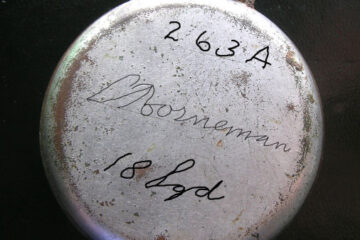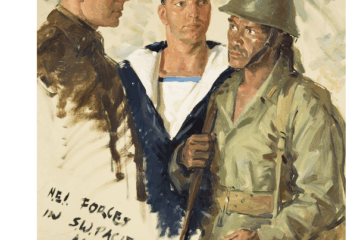During the Second World War, English sailor Henry Alfred Brooklyn (born 27 July 1922 in Cambridge, England; sometimes known as Harry) was decorated with the Netherlands Bronze Cross. This story was brought to our attention by his daughter, Wendy Arrowsmith, and published with her consent.
Brooklyn served on board the Dutch oil tanker MV Ondina during the Second World War. In November 1942 the Ondina, alongside the British Indian H.M.I.S Bengal, was involved in a sea battle with two Japanese ships, the Hokoku Maru and the Aikoku Maru, in the Indian Ocean. The following account of the battle is from the website Traces of War:
“In the morning of 11 November, 1942, HMIS Bengal and the Ondina sailed in line ahead, heading west-north-west. It was a nice and sunny day with a flat sea and excellent visibility. Around 11:30 a lookout of the Ondina saw two ships appear over the horizon at 90 degrees over port at a distance of approximately 12,000 meters. A little bit later the ships were also sighted from the Bengal. Because of the high deckhouses the strange ships for a moment were taken to be aircraft carriers. Because there had been no mentioning at all about allied ships being in the neighborhood, both Ondina and Bengal sounded the alarm and both ships turned 90 degrees to starboard, away from the suspected enemy ships. Around 11:50 Bengal signaled to Ondina to maintain her heading. The Bengal herself turned into the opposite direction in order to catch up head on with the enemy ships and to create time for Ondina to escape.
The enemy ships were recognized to be Japanese auxiliary cruisers and the Bengal steamed straight forward towards the one in front. First they thought that they were facing Hokoku Maru and the smaller Kunikawa Maru (1937). Captain Horsman understood that he would never be able to pick up sufficient speed with his slow tanker to escape from the faster Japanese vessels and decided to face the battle and to support the Bengal with his 10.2cm gun. Just before 12:00 Hokoku Maru opened fire at HMIS Bengal and at 11:58 the corvette send an SOS signal to Fremantle with the message that they and the Ondina were under fire of two Japanese raiders in the position of 19.38 degrees southern latitude and 93.5 degrees eastern longitude, about half way Fremantle and the Chagos Archipellago. HMIS Bengal answered the fire of the Hokoku Maru with her twelve pounder. Second mate Bakker of the Ondina, who was the artillery commander of the tanker and was standing on the poop deck next to the gun, asked permission from captain Horsman to open fire. Steaming away from the approaching Japanese auxiliary cruisers, the captain of the Ondina granted permission. The artillery crew consisted of merchant seaman Visser, Able Seaman B.A. Hammond of the Royal Australian Navy and the Acting Able Bodied Seamen R.H. Bayliss, H.C. Boyce and H.A. Brooklyn of the Royal Navy. The Ondina opened fire when the Hokoku Maru had approached till about 8.000 meters, around 12:05. While the Dutch tanker received her first 14cm hit, which splintered the mast, the first 10.2cm shell of the Ondina went wide and the second hit just in front of the bow of the Japanese auxiliary cruiser. Therewith Second Mate Bakker could adjust his fire and the third grenade hit the deckhouse of the enemy ship. This was an extra ordinary achievement as the Ondina was not equipped with distance measuring equipment nor with fire-guidance. Bakker now diverted his fire to the stern of the Hokoku Maru. Whilst both HMIS Bengal as the Hokoku Maru continued to shoot at each other the fifth or sixth shot of the Ondina caused an enormous explosion on the Japanese auxiliary cruiser. A giant yellowish flame erupted and soon thereafter part of the stern broke off while the wrecked float planes shattered into the sea. The broken part of the rear of the ship sank and wild fires broke out in various places onboard the ship. Thereafter the ship listed heavily to starboard which caused ammunition to roll over and even more explosions erupted.
Aboard the Ondina they could not believe their ears and eyes The artillery crew danced for joy in spite of the fact that some enemy shells hit which damaged the radio antenna and one of the starboard life boats. The Chinese crew members who were not on duty, had sought a safe refuge below deck and AB Seaman Henry did his utmost to keep them composed. The Aikoku Maru now took aim on both ships and placed several hits on both ships that caused little damage though. When the Bengal ran out of ammunition the corvette put up a smoke screen and turned away from the battle around 12:40. One minute later the Bengal was hit again; this time in the rear which caused a fire to start. The crew of the corvette however succeeded to control the fire. The last they saw of the Ondina aboard the Bengal was that the tanker received a hit on the bridge at 13:08 and desperately tried to prevent further hits by changing course all the time a little bit. The corvette after having seen this, sent a coded message with the information that one of the auxiliary cruisers as well as the tanker had been sunk.
Aboard the Hokoku Maru the crew could not control the heavy fires and Commander Hiroshi could do nothing else but to issue the order to abandon ship. In the meantime on board all electrical power had failed and the engine rooms were ablaze. Because the Hokoku Maru was a converted merchant ship she did not have many watertight compartments; consequently the vessel made quickly a lot of water and after another heavy explosion the auxiliary cruiser foundered at 13:12. Of the 354 crew 76 lost their lives amongst whom Captain Hiroshi.
In the meantime Ondina had fired her last 10.2cm shells whilst the Aikoku Maru had closed in on the tanker up to approximately 3.500 meters. Captain Horsman ordered white flags to be hoisted and ordered to abandon ship. The engines had stopped and the crew disembarked the ship in three life boats and two life rafts. The hit that struck the Ondina at 13:08 on her bridge, the last to be seen by the Bengal, killed captain Horsman. The remaining Japanese raider approached the Ondina up till 400 yards and launched two torpedoes towards the abandoned ship that both hit. Large holes were blasted in the starboard side of tanks number 1 and 2. This caused the Ondina to list to about thirty degrees, but remained floating on the other tanks. Thereafter the auxiliary cruiser maneuvered along the bow of the tanker, of which the Japanese thought that its fate had been sealed and started to machine gun the life boats and rafts. This war crime was probably committed out of frustration about the sinking of the Hokoku Maru and the escape of the Bengal. By this machine gunning three Chinese stokers were killed and the chief engineer J.J. Niekerk and ABS Henry were severely wounded. Chief engineer Niekerk died an hour afterwards from his wounds.
At 15:00 the Aikoku Maru had picked up the survivors of her sister ship and returned to the Dutch tanker. The Japanese fired another torpedo but missed. Convinced that the tanker had been lost, the Japanese auxiliary cruiser left the battle scene and sailed away in northerly direction without any further concern about the drowning crew of the Ondina.
After the first mate Rehwinkel had provided a seaman’s grave to the chief engineer, he wanted to return to the Ondina. Of the crewmembers that were with him in the life boat only sailor Visser was prepared to accompany him. The others, Chinese crew members refused to come along as they feared that the Ondina would sink as yet. Second mate Bakker in the meantime, with the motor launch in which he was commander, had returned to the tanker. Together with third engineer Leys, the Australian gunner Hammond and the British artillerist Ryan he boarded the ship which was still on fire in several places. Bakker and the gunners started to pump water into several of the port tanks which slowly righted the Ondina. Leys inspected the engine room and established that the diesel engine was still in working condition. The motor launch was sent to collect the other life boats and rafts and Leys and Bakker went to the bridge where a fire was still burning. The fire was extinguished by both men after which they carried the body of the captain to his cabin. The tanker had in the meantime been righted and the outboard valves could be closed. Around 19:00 all life boats were alongside the tanker and the crews from the rafts had been taken aboard the life boats. The life boats were hoisted on board as good and as bad as this was possible and secured. The stokers and engineers went to work and a few hours later first officer Rehwinkel could give the order ”slow ahead”. And somewhat later even “full ahead”. The heavily damaged tanker set her heading for Fremantle while the crew extinguished the last fires in the forecastle.
The next day captain Horsman received a dignified seaman’s burial. The wounded were cause for serious worry. Especially ABS Henry was in serious condition. He had a crushed leg and had lost a lot of blood and was in urgent need of professional care. After two days the crew of the Ondina was of the opinion to be safe enough to send a radio message and to ask for medical assistance. This message was sent in clear language as, after the order to abandon ship, all secret documents and also the code book had been thrown overboard. The surprising and unexpected message was being received by the allied authorities in Colombo on Ceylon and in Fremantle with disbelieve and mistrust. As the Bengal had indeed reported the Ondina to be sunk and a trap, created by the Japanese in order to lure a ship towards them, was suspected. From Fremantle a signal was sent to inquire about her position. Rehwinkel did not dare to provide this because his clear language message could also be read by the enemy. Therefore medical assistance remained lacking for the time being.
It was not until 17 November before the damaged tanker was reconnoitered by an Australian Catalina flying boat, over 220 nm north-west of Fremantle. Onboard the Ondina shortly before, a ship had been spotted and with signal lamp the Catalina was asked to contact that ship and to ask for the presence of a doctor. The relevant ship turned out to be the Australian hospital ship HMAS Wanganella and it was directed quickly towards the Ondina. By quick handling of the doctors the life of ABS Henry could be saved. The next day the Dutch tanker entered the port of Fremantle after a trip that had not proceeded according to expectations and which had cost the lives of five crew. The day before HMIS Bengal had safely made the harbor of Diego Garcia. The last days the corvette had to sail at slow speed to safe fuel, but there had been no further problems.”
Henry Brooklyn and the other British sailors of the Ondina were awarded the Netherlands Bronze Cross as a result of this battle. Brooklyn’s daughter Wendy still has this medal, and other medals her father received for his military service.

Sources:
- Wendy Arrowsmith
- Traces of War, “Heroic battle of the oil tanker Ondina and HMIS Bengal”
- “Dutch Honour: English and Australian Sailors”, Cairns Post, 13 August 1943, p.5 (via TROVE)
- “Sailors receive Dutch decoration”, Barrier Daily, 10 August 1943, p.1 (via TROVE)
- Admiralty Fleet Orders, 3651-3775/43, 12 August 1943, p.8 (via Australian Navy)


